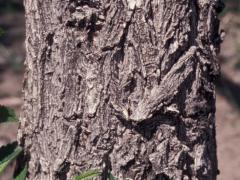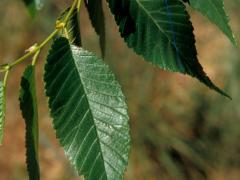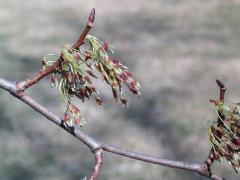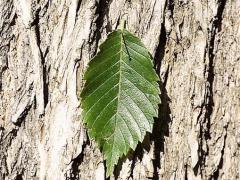Invasive Species: Ulmus pumila, Siberian Elm
Siberian elm is an invasive tree that forms dense thickets, shading and crowding out native plants. It is a deciduous tree that grows up to 70 ft. (21.3 m) in height. The crown is open and rounded, with slender, spreading branches. The leaves are less than 3 in. (7.6 cm) long, alternate, simple, singly serrate, and dark green. The bark is light gray and has irregular furrows. Green, inconspicuous flowers develop in drooping clusters in the spring. Fruits are flat, circular, and 1/2 in. (1.3 cm) wide. The abundant, wind-dispersed seeds allow this plant to spread rapidly. Siberian elm invades pastures, roadsides, and prairies throughout the Midwest and Great Plains regions of the United States. The trees are drought and cold resistant, allowing them to grow in areas where other trees cannot. Siberian elm forms dense thickets that close open areas and displace native plants, thereby reducing forage for wild animals and livestock. Siberian elm is native to northern Asia and was introduced in North America in the 1860s. It has been planted throughout the Midwest and Great Plains for windbreaks and lumber.
What are invasive species, and why should we be concerned about them?
Taxonomy: Scientific and Common Names for This Species
Urticales > Ulmaceae > Ulmus pumila L.
Synonym(s): none
Ulmus pumila – USDA PLANTS Profile
Distribution Maps
Siberian elm – The reported distribution of this invasive species across the United States (Source: Invasive Plant Atlas of the United States)
Up-to-the-minute distribution maps and why they are important
Reporting This Invasive Species
What is the best way to report the occurrence of an invasive species?
How to report an invasive species sighting to EDDMapS – Early Detection & Distribution Mapping System
EDDMapS – Report an invasive species to EDDMapS.
County Extension Offices – Find your county Extension office on this map provided by USDA.
How to Identify
This invasive species can be identified by looking for the characteristics described in the paragraphs that follow.
Tree
Siberian elm is a deciduous tree that grows up to 70 ft. (21.3 m) in height. The crown is open and rounded, with slender, spreading branches. The bark is light gray and has irregular furrows.
|
|
 |
| John M. Randall, The Nature Conservancy, bugwood.org | John M. Randall, The Nature Conservancy, bugwood.org |
Foliage
The leaves are less than 3 in. (7.6 cm) long, alternate, simple, singly serrate, and dark green.
 |
 |
| Steve Dewey, Utah State University, bugwood.org | John M. Randall, The Nature Conservancy, bugwood.org |
Flower
Green, inconspicuous flowers develop in drooping clusters in the spring.
| bugwood.org | bugwood.org |
Fruit
Fruits are flat, circular, and 1/2 in. (1.3 cm) wide. The abundant, wind-dispersed seeds allow this plant to spread rapidly.
 |
 |
| Tom DeGomez, University of Arizona, bugwood.org | Steve Hurst, USDA NRCS PLANTS Database, bugwood.org |
Native Ulmus Species Resemble Siberian Elm
Ulmus americana, American elm – Images at invasive.org
 |
 |
| Paul Wray, Iowa State University, bugwood.org | Tom DeGomez, University of Arizona, bugwood.org |
Ulmus rubra, slippery elm – Images at invasive.org
 |
 |
| Paul Wray, Iowa State University, bugwood.org | Paul Wray, Iowa State University, bugwood.org |
Additional Images for Siberian Elm
Siberian elm – Images at invasive.org
Learning Resources for Siberian Elm
Additional Information, Biology, Control and Management Resources
Control and management recommendations vary according to individual circumstances. Location, habitat, weather, and a variety of other conditions are factors that help determine the best treatment choice. To find the safest and most effective treatment for your situation, consult your state’s land-grant institution. If you will use chemicals as part of the control process, always refer to the product label.
United States Land Grant University System – Find your Land Grant University’s College of Agriculture, University Cooperative Extension Service, or other related partner on this map provided by USDA.
Fact Sheet – Pennsylvania Department of Conservation and Natural Resources
Plant Guide – USDA Natural Resources Conservation Service (NRCS) National Plant Data Center
Weeds Gone Wild: Alien Plant Invaders of Natural Areas – Plant Conservation Alliance
Weed of the Week – USDA Forest Service
Invasive Species – Wisconsin Department of Natural Resources
Invasive Plants Established in the United States That Are Found in Asia and Their Associated Natural Enemies – USDA Forest Service
Terrestrial Invasive Species – Minnesota Department of Natural Resources
Genetic Exchange and Gene Flow Risks From Plants in Agriculture – USDA Agricultural Research Service (ARS)

